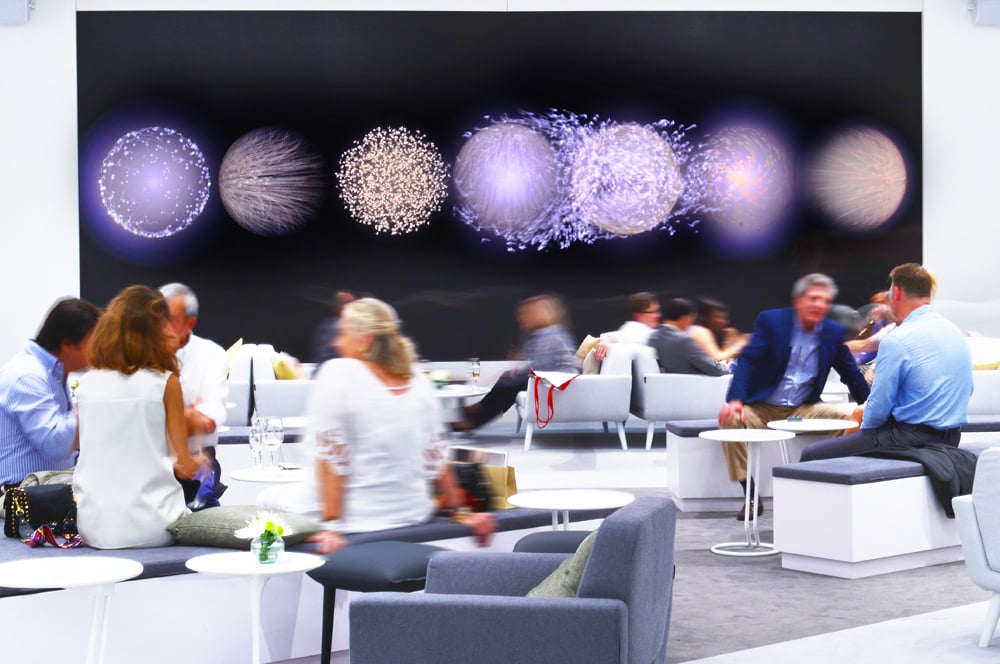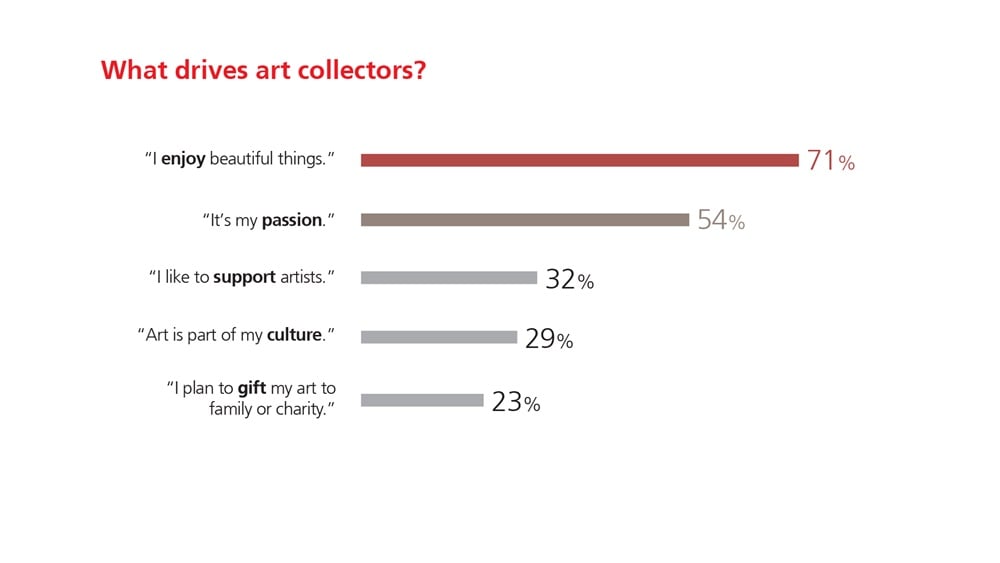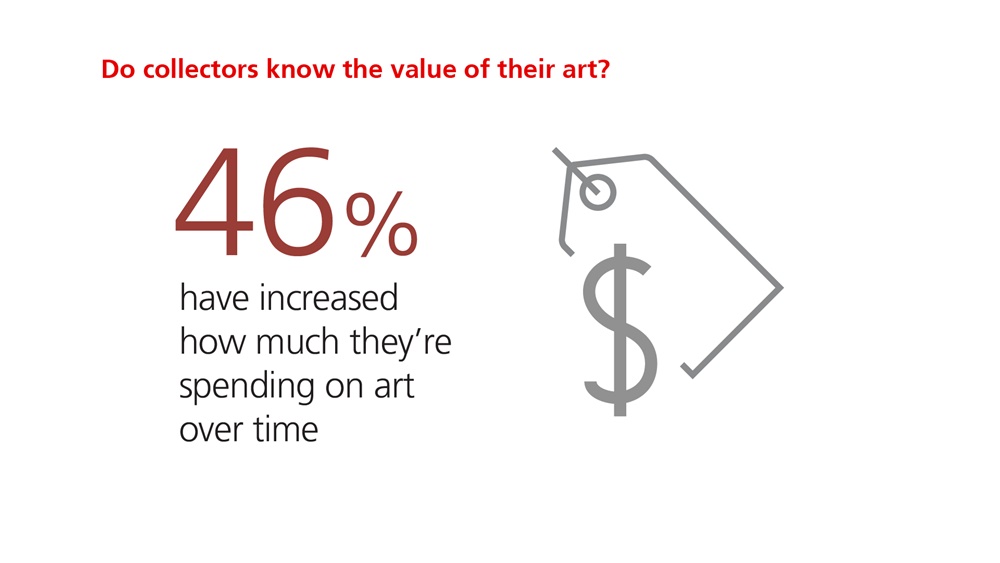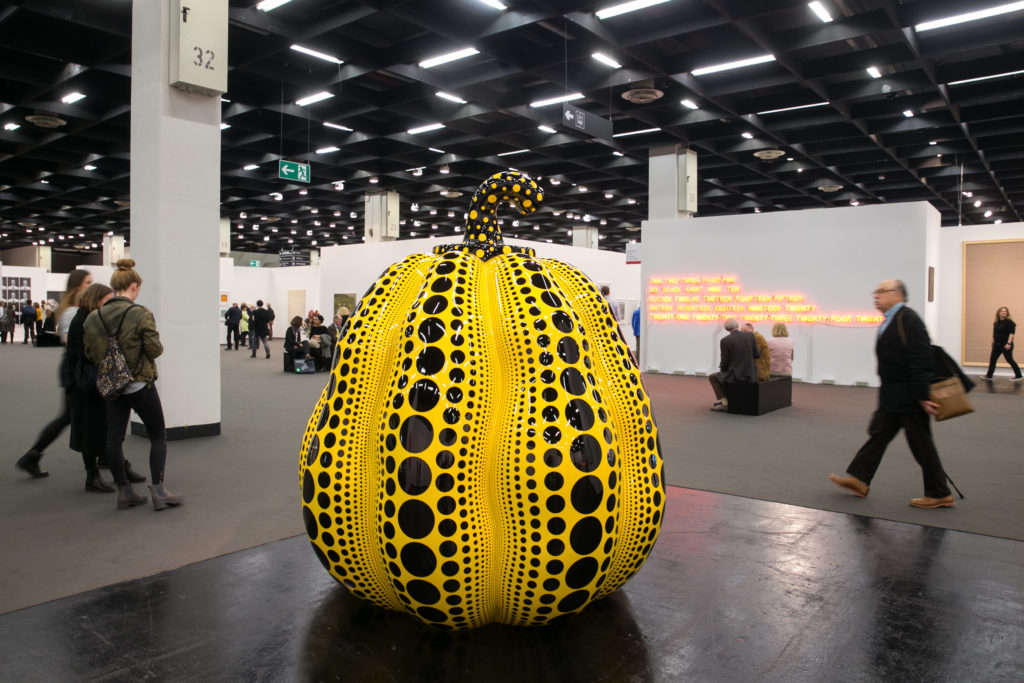The taxi to Zhang Huan’s studio in the suburbs of southwest Shanghai takes over an hour, and deposits me in front of a barred entrance, with a gatekeeper’s hut inside. As the gate slides back, a uniformed guard lets me in; I wait. Soon the studio curator and a translator arrive, and then a photographer, who records every detail of my visit, followed by Zhang Huan himself. Neat, lithe, dressed in his trademark high-necked sweatshirt, glasses propped on his peaked cap, Zhang moves with cat-like grace as he shows me around his domain.
Zhang bought the site, formerly a state-owned hydraulics machine factory, in 2005, after his return to China following 20 years in New York. The sheer scale of the factory/studio begins to dawn on me as we step over train tracks and past three wrecked carriages, one propped up against buffers—salvaged from the 2008 Sichuan earthquake.
The behemoth-like studio reflects two aspects of art production in the second decade of the 21st century: supply and size. Artists need to be able to make work to fill increasingly sprawling spaces; and they need assistants to help, and heavy lifting gear and forklift trucks to move it around.
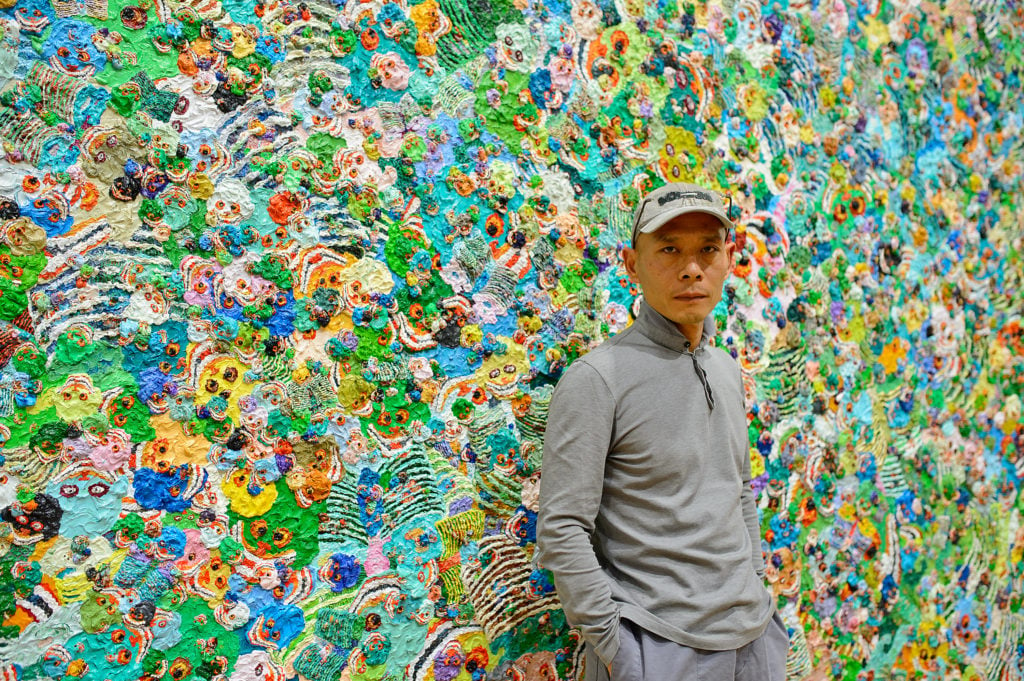
Zhang Huan attends at his exhibition at Pace London in April 2014. (Photo by Ben A. Pruchnie/Getty Images for Pace London)
As author Ursula Pasero has noted, “Many large studios are incorporated and registered as a company and need a turnover of millions of euros or dollars simply to sustain themselves.”
Zhang employs some 80 assistants in the studio, but in the case of large-scale projects (he says he makes about two a year) this can rise to 200. “They stretch and prepare the canvases, separate the ash, apply plaster to sculptures, order materials, work with silicone, but I do the final creation,” says Zhang.
Zhang’s reputation was established in the 1990s with performances, some of them extreme, such as 12m2 (1994), which involved him sitting in a stinking village toilet at the height of summer, covered with honey and fish oil amid swarms of flies.
But while performance was a major part of his early practice, today he and his studio produce mainly painting, sculpture, and video, sometimes on an immense scale. In 2015, an ash painting shown at
Pace Gallery in New York,
June 15, 1964, was 37 meters long and two meters high: it took three years to make, with 10 assistants working on it at a time.
I ask him how many artworks he produces a year, but he doesn’t answer the question, simply responding, “I am under no pressure to produce work. I follow my own ideas.” I certainly do not see many assistants during my visit, although one is scraping away at what looks like a bone in one workshop, while a group are working on some plaster in another.
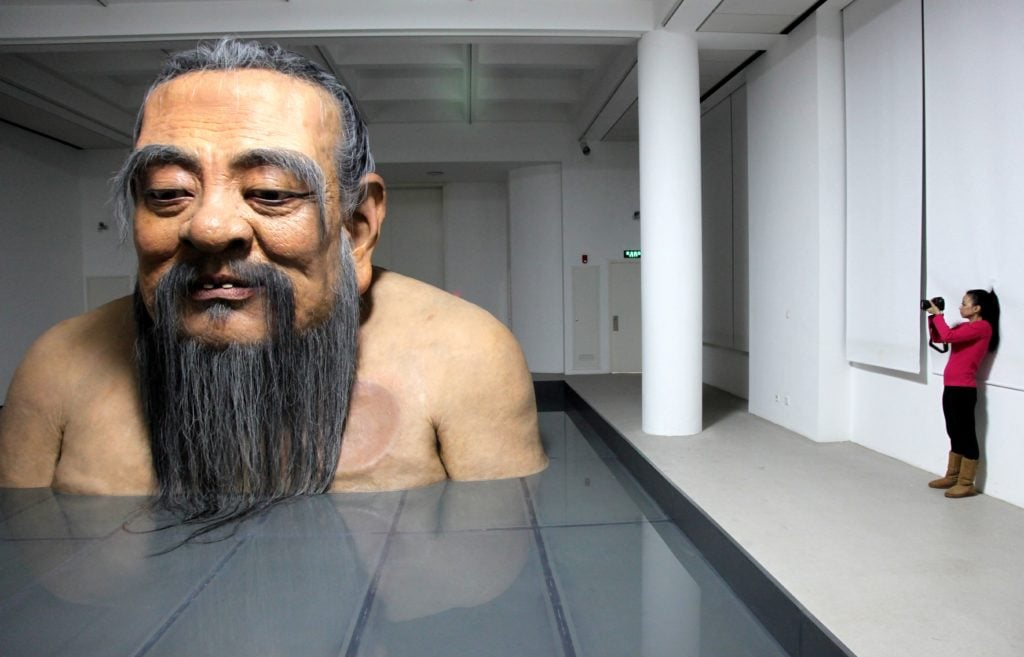
A sculpture of Confucius made by Zhang Huan on view at the Rockbund Art Museum in Shanghai in 2011. (Photo by Olivier Chouchana/Gamma-Rapho via Getty Images)
Zhang’s studio is large, but the factory-like aspect of his practice is by no means unique in China. Other artists, mainly in Beijing, have similarly large studios, often in former factories, leading to accusations of formulaic mass production.
Zhang Xiaogang, for example, according to an interview in the
South China Morning Post has “lost count” of his “Bloodline” series. These expressionless, stiffly posed family portraits that made his reputation in the early 2000s can command immense prices:
Bloodline: Big Family No. 3 (1995) made $12.1 million in Hong Kong in 2014.
As I take my leave, Zhang asks me, “Have you ever seen a studio this big?”
“No,’” I say, “but I am visiting
Sterling Ruby’s in Los Angeles in two weeks’ time. I believe it’s just as big.” I can see he is miffed, disbelieving. He asks me who Sterling Ruby is, and asks me to write out his name.
From Shanghai to Los Angeles
Later that month I ring the bell at an unmarked door in Vernon, an industrial city to the south of downtown Los Angeles. Almost no one lives in Vernon, which is mostly given over to warehouses and factories.
This is where the Californian artist Sterling Ruby has his studio, housed in a former truck factory. Again, I am astonished by the sheer scale of the place, which covers four acres—even though the original vast hangar has been divided up by temporary walls.
In one area are lines of racks of clothing, while long “soft sculptures” are laid out on the floor. In another, shelves are heaped with rolls of fabric while a hoist rope, reaching up 37 feet, suspends sculptures. Oversized glazed ceramics are crowded around kilns; the dappled abstracts Ruby is often associated with hang on the walls.

Sculptures by Sterling Ruby included in the Saatchi Gallery’s exhibition, “The Shape of Things to Come: New Sculpture,” in 2011. (Photo by Oli Scarff/Getty Images)
Outside, there are a number of courtyards; in one stands a forklift truck, in another parts of a chopped-up submarine, while blue tarpaulin cloaks a refurbished bus once used by a Californian prison and a giant canary-yellow “electric chair” stands bleakly against a wall. A battered car is propped up, sitting on a pipe.
Ruby, impeccable and athletically dressed in an orange sweatshirt and green baseball cap, tells me he has between 12 and 20 assistants in the studio, where he moved in 2014.
“I was paying a lot for storage of artworks, and I thought, why not have somewhere to keep everything together. This is where I can realize my dreams!” he said.
If the studio complex is large, then so is Ruby’s packed exhibition schedule—with 18 exhibitions in 2016 alone, demanding hyper-prolific output to supply them. His practice ranges from quilts and “vampire mouth” soft sculptures through metal “stoves,” ceramics, video, photography, flags, and abstract paintings to towering stalagmites made of shiny urethane.
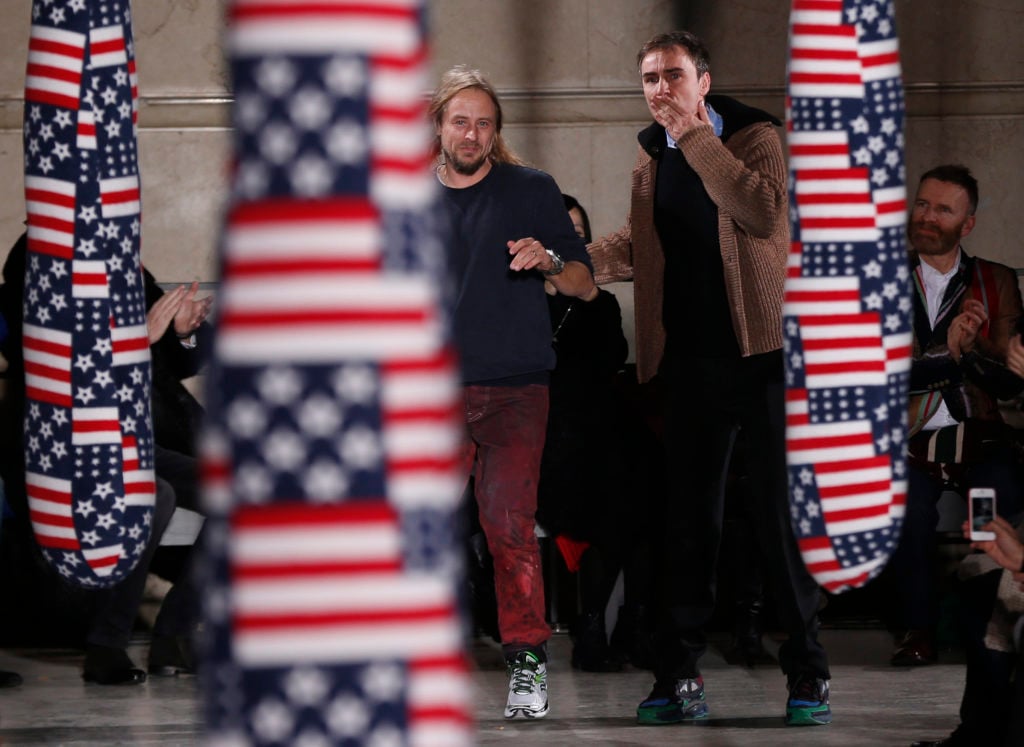
Raf Simons (right) and Sterling Ruby salute the audience after their Fall/Winter 2014-2015 men’s fashion show in Paris on January, 15, 2014. (FRANCOIS GUILLOT/AFP/Getty Images)
“Production is not a problem, but I never make work specifically for shows,” he tells me. And then there are his fashion designs, which include paint-splattered “work wear” produced from offcuts of other projects, and a collaboration with fashion designer Raf Simons, whose flagship store Ruby designed. Images from Ruby’s paintings on dresses and a coat were used for Simons’s first haute couture collection for Dior in 2012.
As one of the hottest artists in the contemporary art scene, Ruby has been unabashedly commercial in driving his career, burning through galleries. At the time of my visit, he was represented by Foxy Production, Gagosian,
Sprüth Magers, Taka Ishii, and
Xavier Hufkens, having left the mega-player
Hauser & Wirth in 2015.
Supply and Size: What the Market Wants
Outsiders to the art market often find it difficult to comprehend the importance of supply in the art market. This is not an industry like most others, where the problem lies in finding buyers for your product.
The problem here is to find desirable works for sale, notably on the secondary market. In the primary market, there is a theoretically endless supply as living artists create new work. The reality is more complicated. Galleries control the market for their artists, “rationing” it in order to maintain prices and high demand. Only a small number of artists account for the bulk of the market and so the pressure on them to produce enough for their galleries can be intense.
The demand is not only for quantity—it is also for works of a certain size. And while “huge” art is not a modern phenomenon—centuries-old artworks such as the Sistine Chapel in Rome or the great Baroque palaces in St Petersburg were vast undertakings—a number of elements in today’s world have stimulated the need for large-scale artworks.
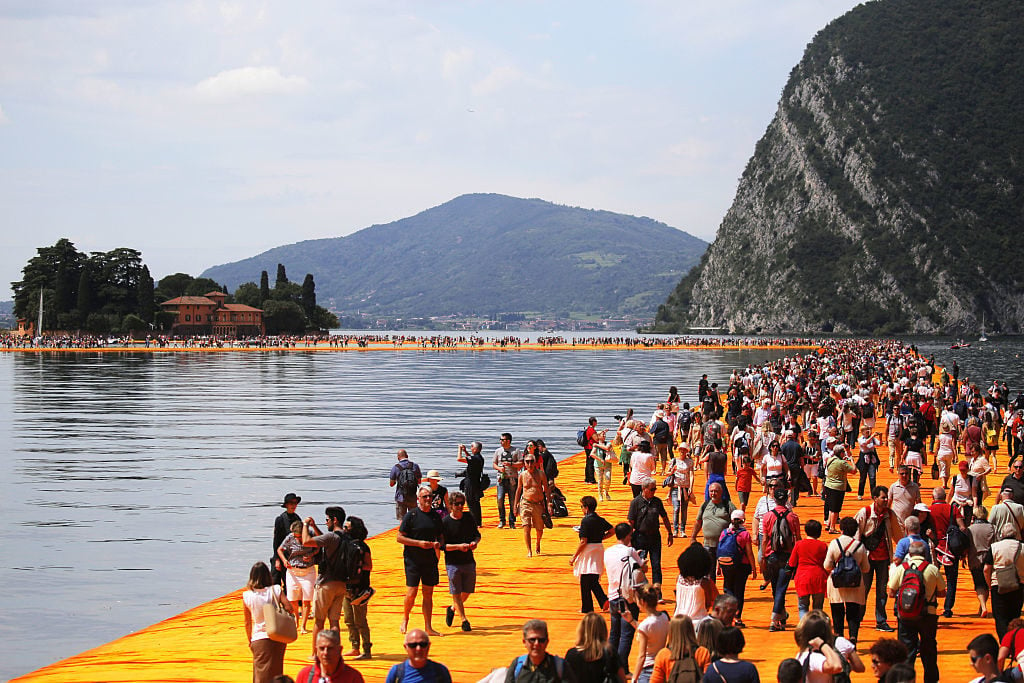
Visitor numbers to Christo’s Floating Piers (2016) overwhelmed local authorities. Photo: MARCO BERTORELLO/AFP/Getty Images.
Public institutions are pressured by the need to attract the public with a “wow” factor; huge new private museums want impactful, striking works; and even the increasing magnitude of buildings in urban spaces has demanded scaled-up public projects. Examples range from the “Monumenta” series of installations in the Grand Palais, Paris, or Tate’s Turbine Hall projects in London, to Christo’s three-kilometer Floating Piers project across Italy’s Lake Iseo—all part of an event culture that demands BIG.
This appetite for size is mirrored by the growth of the major art galleries, as illustrated by Hauser & Wirth’s massive Los Angeles space, a sprawling, 100,000-square-foot former flour mill converted into galleries, a sculpture garden, restaurant, and shop.
“Over-production is a serious problem; I would say the limit was reached in 2013 or 2014,” says Stéphane Custot, the owner of the London gallery
Waddington Custot. “And it has got to change, because it could eventually destroy confidence in the contemporary art market.’”
Demand From All Sides
The art market almost doubled between 2005 and 2015 when it reached $63.3 billion, before falling back to $56.6 billion in 2016, for both for sales at auction and those through dealers (though the latter are trickier to evaluate).
And yet this extraordinary leap in size of art sales is only part of the story; the most astonishing aspect is how contemporary art has come to dominate the market today, with growth in demand from many different sectors, and not just for buying and selling.
“The cross-pollination of celebrity culture, fashion and glamour has given contemporary art in general, and art events in particular, a promise of enjoyment, excitement and the promise of exclusivity,” writes the art advisor and collector Marta Gnyp.
There is now a proliferation of books, websites, articles devoted to artists and exhibitions in magazines, fashion and luxury goods tie-ups, plus the rapidly expanding calendar of biennales, art fairs and displays around the world.

Jeff Koons with one of his Louis Vuitton Masters bags. Photo courtesy of Louis Vuitton.
Art is used to sell real estate, to brand a hotel, to give a new building project or a restaurant the most hip and “now” credentials. At the Art Basel Miami Beach fair, alongside the 20 or more satellite events, even companies such as Uber, Airbnb, Volvo and Mazda, as well as a gourmet food company, Dean and DeLuca, have put on art-inspired projects, while luxury goods firms also tout their products with art.
All this needs supply. And possibly one of the main reproaches leveled against today’s art market, particularly the higher-end segment, is that of over-production, with some well-known artists locked into producing more and more—often similar—works, just to satisfy the demands of all these events.
Indeed, any visitor to a major art fair will be struck by the similarity of offerings by the major galleries, from a mirrored sculpture by
Anish Kapoor(the “Pottery Barn of void,” quips one dealer) to a spotted Kusama pumpkin. As the New York-based journalist Christian Viveros-Fauné puts it: “You can only get so much out of a single artist—and the market wants repetition rather than innovation.”
This is an edited excerpt from Georgina Adam’s forthcoming book, Dark Side of the Boom. Adam is a London-based journalist and writer, editor at large for The Art Newspaper
, and a contributor to the Financial Times
. The book, which focuses on the excesses of the art market in the 21st century, will be published on January 5 by Lund Humphries.
Follow artnet News on Facebook:
Want to stay ahead of the art world? Subscribe to our newsletter to get the breaking news, eye-opening interviews, and incisive critical takes that drive the conversation forward.

